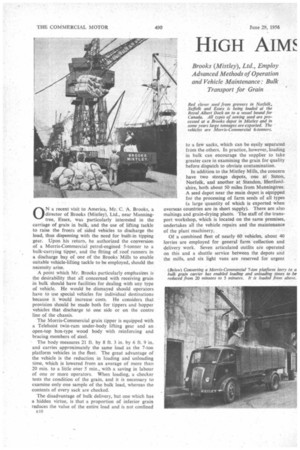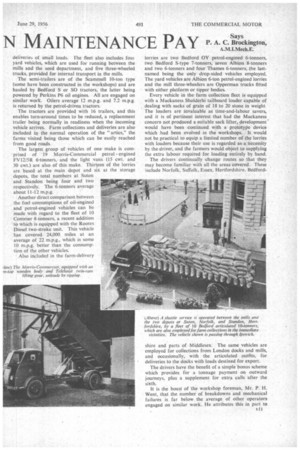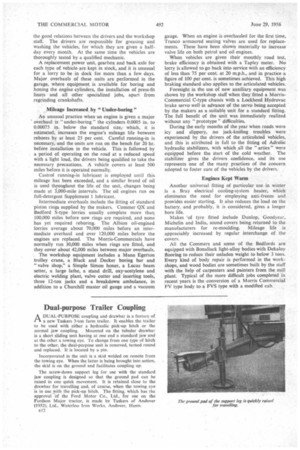HIGH AIMS
Page 62

Page 63

Page 64

If you've noticed an error in this article please click here to report it so we can fix it.
N MAINTENANCE PAY Says P. A. C. .m.BLLOCechkllgt0a, .iE
Brooks (Mistley), Ltd., Employ Advanced Methods of Operation and Vehicle Maintenance: Bulk Transport for Grain
ON a recent visit to America, Mr. C. A. Brooks, a director of Brooks (Mistley), Ltd., near Manningtree, Essex, was particularly interested in the carriage of grain in bulk, and the use of lifting tackle to raise the fronts of sided vehicles to discharge the load, thus dispensing with the need for built-in tipping gear. Upon his return, he authorized the conversion of a Morris-Commercial petrol-engined 5-tonner to a bulk-carrying tipper, and the fitting of roof runners in a discharge hay of one of the Brooks Mills to enable suitable vehicle-lifting tackle to be employed, should the necessity arise.
A point which Mr. Brooks particularly emphasizes is the desirability that all concerned with receiving grain in bulk should have facilities for dealing with any type of vehicle. He would he dismayed should operators have to use special vehicles for individual destinations because it would increase costs. He considers that provision should be made both for tippers and hopper vehicles that discharge to one side or on the centre line of the chassis.
The Morris-Commercial grain tipper is equipped with a Telehoist twin-ram under-body lifting gear and an open-top box-type wood body with reinforcing and bracing members of steel.
The body measures 21 ft. by 8 ft. 3 in. by 6 ft. 9 in, and carries approximately the same load as the 7-ton platform vehicles in the fleet. The great advantage of the vehicle is the reduction in loading and unloading time, which is lowered from an average of more than 20 min. to a little over 5 min., with a saving in labour of one or more operators. When loading, a checker tests the condition of the grain, and it is necessary to examine only one sample of the bulk load, whereas the contents of every sack are checked.
The disadvantage of bulk delivery, but one which has a hidden virtue, is that a proportion of inferior grain reduces the value of the entire load and is not confined
to a few sacks, which can be easily separated from the others. In practice, however, loading in bulk can encourage the supplier to take greater care in examining the grain for quality before dispatch to obviate contamination.
In addition to the Mistley Mills, the concern have two storage depots, one at Suton, Norfolk, and another at Standon, Hertfordshire, both about 50 miles from Manningtree. A seed depot near the main depot is equipped for the processing of farm seeds of all types (a large quantity of which is exported when overseas countries are in short supply). There are also malt jigs and grain-drying plants. The staff of the transport workshop, which is located on the same premises, undertakes all the vehicle repairs and the maintenance of the plant machinery..
Of a combined fleet of nearly 60 vehicles, about 40 lorries are employed for general farm collection and delivery work. Seven articulated outfits are operated on this and a shuttle service between the depots and the mills, and six light vans are reserved for urgent deliveries of small loads. The fleet also includes foto yard vehicles, which are used for running between the mills and the seed department, and five three-wheeled trucks, provided for internal transport in the mills.
The semi-trailers are of the Scammell 10-ton type (some have been constructed in the workshops) and are hauled by Bedford S or SO tractors, the latter being powered by Perkins P6 oil engines. All are engaged on similar work. Oilers average 12 m.p.g. and 7.2 m.p.g. is returned by the petrol-driven tractors.
The tractors are provided with 16 trailers, and this enables turn-around times to be reduced, a replacement trailer being normally in readiness when the incoming vehicle arrives. Farm collections and deliveries are also included in the normal operation of the " artics," the farms visited being those which can be easily reached from good roads.
The largest group of vehicles of one make is comprised of 19 Morris-Commercial petrol engined FV12/5R 6-tonners, and the light vans (15 cwt. and 30 cwt.) are also of this make. Thirteen of the lorries are based at the main depot and six at the storage depots, the total numbers at Suton and Standon being four and two respectively. The 6-tonners average about 11-12 m.p.g.
Another direct comparison between , the fuel consumptions of oil-engined and petrol-engined vehicles can be made with regard to the fleet of 10 Commer 8-tonners, a recent addition to which is equipped with the Rootes Diesel two-stroke unit. This vehicle has covered 24,000 miles at an average of 22 m.p.g., which is some 10 m.p.g. better than the consumption of the other vehicles.
Also included in the farm-delivery lorries are two Bedford OY petrol-engined 6-tonners, two Bedford S-type 7-tonners, seven Albion 8-tonners and two 6-tonners and four Thames 6-tonners, the lastnamed being the only drop-sided vehicles employed. The yard vehicles are Albion 6-ton petrol-engined lorries and the mill three-wheelers are Opperman trucks fitted with either platform or tipper bodies.
Every vehicle in the farm collection fleet is equipped with a Mackaness Sholderhi tailboard loader capable of dealing with sacks of grain of 18 to 20 stone in weight The loaders are invaluable as time-and-labour savers, and it is of pertinent interest that had the Mackaness concern not produced a suitable sack lifter, development would have been continued with a prototype device which had been evolved in the workshops. It would not be practical to equip a limited number of the lorries with loaders because their use is regarded as a necessity by the driver, and the farmers would object to supplying the extra labour required for loading entirely by hand.
The drivers continually change routes so that they may become familiar with all the areas covered. These include Norfolk. Suffolk, Essex, Hertfordshire, Bedford shire and parts of Middlesex. The same vehicles are employed for collections from London docks and mills, and occasionally, with the articulated outfits, for deliveries to the docks with loads destined for export.
The drivers have the benefit of a simple bonus scheme which provides for a tonnage payment on outward journeys, plus a supplement for extra calls after the sixth.
It is the boast of 'the workshop foreman, Mr. P. H.
Went, that the number of breakdowns and mechanical failures is far below the average of other operators engaged on similar work. He attributes this in part to the good relations between the drivers and the workshop staff. The drivers are responsible for greasing and washing the vehicles, for which they are given a halfday every month. At the same time the vehicles are thoroughly tested by a qualified mechanic.
A replacement power unit, gearbox and back axle for each type of vehicle are kept in stock, and it is unusual for a lorry to be in dock for more than a few days. Major overhauls of these units are performed in the garage, where equipment is available for boring and honing the engine cylinders, the installation of press-fit liners and all other specialized jobs, apart from regrinding crankshafts.
• Mileage Increased by " Under-boring " An unusual practice when an engine is given a major overhaul is" under-boring" the cylinders 0.0005 in. to 0.00075 in. below the standard size,which, it is estimated, increases the engine's mileage life between rebores by at least 25 per cent. Careful running-in is necessary, and the units are run on the bench for 20 hr. before installation in the vehicle. This is followed by a period of operating on the road at a reduced speed with a light load, the drivers being qualified to take the necessary precautions. A vehicle covers at least 500 miles before it is operated normally.
Castrol running-in lubricant is employed until this mileage has been exceeded, and a similar brand of oil is used throughout the life of the unit, changes being made at 3,000-mile intervals, The oil engines run on full-detergent Supplement 1 lubricant.
Intermediate overhauls include the fitting of standard piston rings supplied by the makers. Commer QX and Bedford S-type lorries usually complete more than 100,000 miles before new rings are required, and none has yet required reboring. The Albion oil-engined lorries average about 70,000 miles before an intermediate overhaul and over 120,000 miles before the engines are replaced. The Morris-Commercials have normally run 30,000 miles when rings are fitted, and they cover about 42,000 miles between major overhauls. . The workshop equipment includes a Mann Egerton trolley crane, a Black and Decker boring bar and "valve shop," a Simple Simon honer, a Lucas beam setter, a large lathe, a stand drill, oxy-acetylene and electric welding plant, valve cutter and inserting tools, three 12-ton jacks and a breakdown ambulance, in addition to a Churchill master oil gauge and a vacuum
gauge. When an engine is overhauled for the first time, Tranco armoured seating valves are used for replacements. These have been shown materially to increase valve life on both petrol and oil engines.
When vehicles are given their monthly road test, brake efficiency is obtained with a Tapley meter. No lorry is allowed to go back into service with an efficiency of less than 75 per cent. at 20 m.p.h., and in practice a figure of 1.00 per cent. is sometimes achieved. This high braking standard also applies to the articulated vehicles_
Foresight in the use of new auxiliary equipment was shown by the workshop staff when they fitted a MorrisCommercial C-type chassis with a Lockheed Hydrovac brake servo well in advance of the servo being accepted by the makers as a suitable unit for a standard fitting. The full benefit of the unit was immediately realized without any " prototype " difficulties.
During the early months of the year when roads were icy and slippery, no jack-knifing troubles were experienced by the drivers of the articulated vehicles, and this is attributed in full to the fitting of Adrolic hydraulic stabilizers, with which all the " artics " were equipped before the start of the cold weather. The stabilizer gives the drivers confidence, and its use represents one of the many practices of the concern adopted to foster care of the vehicles by the drivers.
Engines Kept Warm
Another universal fitting of particular use in winter is a Bray electrical cooling-system heater, which eliminates the need for employing anti-freeze and provides easier starting. It also reduces the load on the battery, and probably, it is considered, gives a longer bore life.
Makes of tyre fitted include Dunlop, Goodyear, Michelin and India, sound covers being returned to the manufacturers for re-moulding. Mileage life is appreciably increased by regular interchange of the covers.
All the Commers and some of the Bedfords are equipped with Bonallack light-alloy bodies with Dekaloy flooring to reduce their unladen weight to below 3 tons. Every kind of body repair is performed in the workshops, and wood bodies are-sometimes built by the staff with the help of carpenters and painters from the mill plant. Typical of the more difficult jobs completed in recent years is the conversion of a Morris Commercial FV type body to a FVS type with a modified cab.
















































































































































